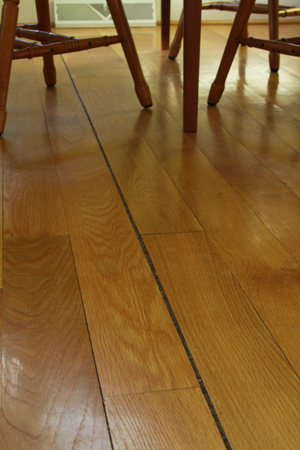
Can I clean out the cracks in my floor and fill them with a paste made with glue and fine sawdust? If so, what type of glue should I use that would dry clear? Or should I leave them alone and hope they close up when the humidity rises during the summer? Some of the boards were probably not dry enough to deal with the dry heat without shrinking. Thanks for any suggestions. – Al Harrelson
Rob Johnstone: I think you are correct that the cause of the open spaces between the oak flooring is from your heat source drying the air, and then lower relative humidity allows the flooring to lose moisture content. As the moisture content in the oak flooring lowers, it will shrink. Next summer, it will swell back to how it was. For that reason, if you put something into the cracks now, it would be squeezed clear of the cracks in the summer. So, I strongly suggest not filling the cracks with anything.
Even if you did use the oak sanding dust and mixed it with hide glue (one of the appropriate binders for that task), the chances of the cracks disappearing visually is almost zero. The color and texture of the filler would be different than the flooring, and it may turn out to be more unsightly than the cracks.
Chris Marshall: We have the same problem right down the middle of our kitchen floor, and I’m guessing your hypothesis is correct: the lumber wasn’t sufficiently seasoned and dried before it was installed. It had more shrinking to do, and unfortunately, that happened after our floors were nailed down. During the heating season, our kitchen floor gap will open to a full 1/4-in. wide, and in muggy August, it’s less than 1/16-in. wide. With that kind of wood movement, no glue-and-sawdust concoction is going to work for me. If your cracks are very, very narrow, it might work, but I’m talking about gaps so small that the average person wouldn’t pay attention to them anyway. As you will expect, fill the gaps during the summer, and they’ll open again in winter. Fill them in winter, and that “putty” will be forced out in summer. I wouldn’t go through the effort. In my own situation, I’m considering replacing the boards on either side of the crack with slightly wider options the next time the floor needs refinishing and hoping that the replacements will be less reactive than their predecessors are. Or, ripping the floor up entirely and switching to tile… At least that wouldn’t need refinishing!
Tim Inman: Putting sawdust in those cracks would be akin to adding insult to injury in my book. Fix the real problem, and you’ll be a happier man. Get a humidifier and/or put a heat resist floor covering down in front of your stove. If you just load up those cracks with glue and sawdust now when the wood is super dry, you won’t be happy when you go back to the lake next summer. You’ll find lumps of stuff sticking up where the cracks used to be. Wood moves as humidity and temperature change. You already know that. Address the temperature and humidity issues to keep your floor (and everything else wood in your house) nice, and use the sawdust in your meat smoker. Make furniture with the glue.





